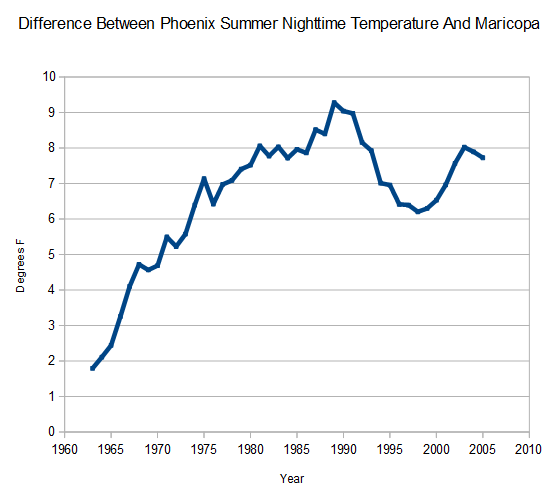Climate experts tells us that UHI isn’t important, as indicated by the eight degrees of UHI measured by the National Weather Service in Phoenix
Disrupting the Borg is expensive and time consuming!
Google Search
-
Recent Posts
- The World’s Worst Scientists
- “Trees are feasting on decades of carbon dioxide emissions”
- A Real Hockey Stick
- A Real Hockey Stick
- Doubling Energy Costs
- Doubling Energy Costs
- “You Can’t Hide Your Lying Eyes”
- Australia Permanent Drought Update
- Let Them Burn Wood
- “New computer modeling”
- Climate Destroying Shrimp
- What’s At Stake?
- Too Hot To Live
- What’s At Stake?
- “The world began to end on 12th May 2024”
- “Climate change is a myth”
- Racist Gas
- RFK Jr. Discusses The Green New Deal And Climate
- “world is on edge of climate abyss, UN warns”
- Ivy Echo Chamber
- Climate Homicide
- Much Ado About Nothing
- Homophobic Gas
- World Bank Expectations
- Trained Not To Learn
Recent Comments
- Conrad Ziefle on The World’s Worst Scientists
- arn on “Trees are feasting on decades of carbon dioxide emissions”
- Francis Barnett on “Trees are feasting on decades of carbon dioxide emissions”
- arn on “Trees are feasting on decades of carbon dioxide emissions”
- Steve Cooksey on “Trees are feasting on decades of carbon dioxide emissions”
- spren on “You Can’t Hide Your Lying Eyes”
- Jack the Insider on Doubling Energy Costs
- Conrad Ziefle on Doubling Energy Costs
- Disillusioned on Doubling Energy Costs
- Francis Barnett on Doubling Energy Costs



Hi Steven Goddard,
While I agree wholeheartedly with you that the current “global warming” estimates are seriously biased by UHI, I don’t agree with your claim that: “Climate experts tells us that UHI isn’t important”
Most of the groups calculating global temperature trends do recognise that large cities such as Phoenix, AZ have substantial UHI effects. The claim is not that they are irrelevant, but rather that they have already been checked and accounted for in the global analyses:
1. Some studies claim to have shown that averaged globally the temperature trends are fairly similar, regardless of whether you include urban or rural stations, e.g., Jones et al., 1990; Easterling et al., 1997; Peterson et al., 1999; Peterson, 2003; Parker, 2006; Wickham et al., 2013
2. NASA GISS believe that their “urbanization bias adjustment” computer program is able to remove the UHI bias from their global temperature trends, yet their estimates look fairly similar to the ones that don’t explicitly correct for UHI
3. Several groups assume that climate record homogenization algorithm used by NOAA NCDC (Menne & Williams, 2009) is able to remove any “non-climatic bias”, including urbanization bias. Therefore, groups such as CRU, JMA, NCDC assume that if they use the “homogenized” data, they don’t need to worry about UHI.
—
However, having said that, a few years ago, we decided to look critically at each of these claims in turn… just to check! After several years of analysing the data, we have found that all three of the above claims are invalid. UHI is a serious problem, after all (as you are claiming)!
We have recently submitted our findings for open peer review at a new forum we have set up called the Open Peer Review Journal as a series of three companion papers (“Urbanization bias” Parts 1 – 3), but we also provide a less technical summary on our Global Warming Solved blog: http://globalwarmingsolved.com/2013/12/summary-urbanization-bias-papers-1-3/.
I think you might find our analysis interesting, and that it agrees with some of what you’re saying…
Living here in the valley I can confirm there is 5 to 6 degrees of difference just by the time you get from Tempe, AZ to the edge of the Indian reservation on the South side of Chandler, AZ. I doubt there was any decrease from 1990 onward, since the amount of asphalt and energy use has only increased since then.
One really interesting thing is driving at night on the highways. Leave your widows open when going under an overpass and you can literally feel a pulse of heat from all the concrete above you after it has spent all day in the sun.
And just how much of the UHI is being adjusted out of the Phoenix temperature records? When you look at the amount of UHI you would expect to find almost no daily record high temperatures left on the books from before 1965.
Chris,
I have measured the exact locations you have mentioned many times; and yes it is what you say plus maybe a degree. Humidity also varies with the rural areas more humid. These numbers are real.
Just the air wash off of the river was 10-15° lower over ¼-mile, you could feel the cold come rushing in your car windows as you came up towards 34th Street on those warm Summer nights (but it was always after dark when you felt it, wasn’t it?). Of course, we know that any measured temperature can be accurately extrapolated over 1200km using a simple, linear formula that doesn’t vary by more than 5°, yeah.